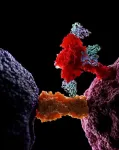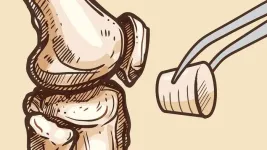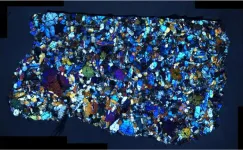(Press-News.org) INDIANAPOLIS — Nearly 3% of all children in the United States are diagnosed with autism, according to the Centers for Disease Control and Prevention. But a collaborative team of researchers at Indiana University and Purdue University are finding ways to make the right diagnosis sooner.
“The number of children needing autism evaluations exceeds the capacity of specialists trained to provide this service,” said Rebecca McNally Keehn, PhD, assistant professor of pediatrics at the IU School of Medicine. “Children and their families are currently waiting a year or more to access evaluations. This is a problem because children miss opportunities for interventions at the optimal time of impact.”
McNally Keehn is the senior author of a paper recently published in JAMA Network Open that describes the research team’s study of autism diagnosis using eye tracking biomarkers at primary care clinics across Indiana. The team traveled to practices participating in the Indiana Early Autism Evaluation Hub system and conducted a blind research-grade evaluation of 146 children aged 14-48 months.
“Diagnostic biomarkers are characteristics that provide discrete and objective indication of diagnosis. Eye-tracking biomarkers that measure social and nonsocial attention and brain function have been shown to differentiate young children diagnosed with autism from those with other neurodevelopmental disabilities,” McNally Keehn said. “However, despite enormous investment in eye-tracking biomarker discovery, there has been a gap in the translation of eye-tracking biomarkers into clinical benefit.
To do the eye tracking, children in the study sat in a highchair or caregiver’s lap and watched videos on a computer screen, while the researchers recorded their eye movements and pupil size. When primary care clinician diagnosis and diagnostic certainty was combined with eye-tracking biomarker metrics, the sensitivity of the model was 91% and the specificity was 87%, meaning that they made a more accurate autism diagnosis.
McNally Keehn said studies like these can help address delays in access to autism evaluations by better equipping primary care clinicians with a multi-method, diagnostic approach.
“This is a public health issue, and our approach has the potential to substantially improve access to timely, accurate diagnosis in local communities,” McNally Keehn said.
The team’s next step is to conduct a large-scale replication and validation study of their diagnostic model using artificial intelligence. Then, they hope to conduct a clinical trial studying the effectiveness of the diagnostic model in real-time primary care evaluations.
Other study authors include Patrick Monahan, Brett Enneking, Tybytha Ryan, and Nancy Swigonski of IU and Brandon Keehn of Purdue.
About IU School of Medicine
The IU School of Medicine is the largest medical school in the U.S. and is annually ranked among the top medical schools in the nation by U.S. News & World Report. The school offers high-quality medical education, access to leading medical research and rich campus life in nine Indiana cities, including rural and urban locations consistently recognized for livability. According to the Blue Ridge Institute for Medical Research, the IU School of Medicine ranks No. 13 in 2023 National Institutes of Health funding among all public medical schools in the country.
END
Eye-tracking techniques could help primary care providers diagnose autism sooner, more accurately
2024-05-31
ELSE PRESS RELEASES FROM THIS DATE:
Antibodies may aid effort to fight influenza B: Study
2024-05-31
Researchers at Vanderbilt University Medical Center have isolated human monoclonal antibodies against influenza B, a significant public health threat that disproportionately affects children, the elderly and other immunocompromised individuals.
Seasonal flu vaccines cover influenza B and the more common influenza A but do not stimulate the broadest possible range of immune responses against both viruses. In addition, people whose immune systems have been weakened by age or illness may not respond effectively to the flu shot.
Small-molecule drugs that block neuraminidase, a major surface glycoprotein of the ...
ASCO: Novel CAR T therapy and shorter targeted therapy durations show promise for patients with leukemia
2024-05-31
Novel CAR T cell therapy obe-cel yields strong remission rates in adults with relapsed or refractory B-ALL (Abstract 6504)
The novel anti-CD19 autologous chimeric antigen receptor (CAR) T cell therapy obecabtagene autoleucel (obe-cel) achieved durable remissions in 40% of patients with relapsed or refractory B-ALL without a subsequent stem cell transplant (SCT), according to results from the Phase Ib/II FELIX clinical trial presented today by Elias Jabbour, M.D., professor of Leukemia.
At a median follow-up of 21.5 months, these patients were in ongoing remission ...
Synthetic plugs offer alternative to total knee replacements
2024-05-31
Osteochondral defects (OCDs) can cause damage to cartilage and underlying bone, leading to chronic pain and loss of joint function. Depending on the extent of damage, individuals must undergo surgical treatment, the most extensive being total knee replacement, which over 800,000 Americans undergo each year.
Dr. Melissa Grunlan, professor in the Department of Biomedical Engineering at Texas A&M University, received a grant from the National Institute of Arthritis and Musculoskeletal and Skin Disease, a suborganization of the National Institutes ...
CU researchers analyze prevalence, impact of ethical or religious barriers to providing medical aid in dying
2024-05-31
Recently published research led by the University of Colorado Anschutz Medical Campus examined the prevalence — and impact — of physicians’ ethical or religious barriers to their involvement in medical aid in dying (MAiD), a multi-step process where a physician provides a terminally ill adult with decision-making capacity with a lethal dose of medication to end their life.
The research article, “Conscience-Based Barriers to Medical Aid in Dying: A Survey of Colorado Physicians,” was published this May in the Journal of General Internal Medicine. It shows that 26% of physician ...
Want to be a successful scientist? The McClements family has some tips
2024-05-31
The latest book of prolific author David Julian McClements is a family affair. The Distinguished Professor of Food Science, along with his daughter Isobelle Farrell McClements and nephew Jake McClements, have written “How to be a Successful Scientist: A Guide for Graduate Students, Postdocs, and Professors” (Springer, 2024).
The three authors offer different perspectives as scientists at different stages in their careers. Julian McClements, who has published more than 1,300 scientific articles and numerous books, is the most highly ...
Overcoming barriers to heat pump adoption in cold climates and avoiding the 'energy poverty trap'
2024-05-31
Converting home heating systems from natural gas furnaces to electric heat pumps is seen as a way to address climate change by reducing greenhouse gas emissions.
But a new University of Michigan study of 51 Southeast Michigan households shows that switching to efficient, cold-climate heat pumps would increase annual utility bills by an average of about $1,100.
Home weatherization upgrades, such as adding attic insulation and sealing around doors and windows, could help reduce utility bills and make ...
A new way to see viruses in action
2024-05-31
A new, nano-scale look at how the SARS-CoV-2 virus replicates in cells may offer greater precision in drug development, a Stanford University team reports in Nature Communications. Using advanced microscopy techniques, the researchers produced what might be some of the most crisp images available of the virus’s RNA and replication structures, which they witnessed form spherical shapes around the nucleus of the infected cell.
“We have not seen COVID infecting cells at this high resolution and known what we are looking at before,” said Stanley Qi, ...
Wealthier neighborhoods in Boulder saw lower bee diversity
2024-05-31
Community gardens in higher-income Boulder neighborhoods have fewer varieties of bees than their medium-income counterparts, new University of Colorado Boulder research suggests. Scientists suggest that people in these neighborhoods tend to apply more landscaping practices, such as using fertilizers, which could impact bees’ habitats.
The finding appeared May 22 in the journal Urban Ecosystems.
“Bees are so important for local ecosystems through their pollination services. The landscape would not look the same without our pollinators,” ...
Advancing excellence top priority for new board chair
2024-05-31
At its annual meeting on Thursday, the University of Miami Board of Trustees (BOT) confirmed Manuel “Manny” Kadre as its new chair, Wayne Chaplin and Bill Morrison as new vice chairs, and welcomed a slate of new trustees.
Kadre, chairman and chief executive officer of MBB Auto Group as well as a senior executive and shareholder of a number of beverage, automotive, health care, and real estate companies, first joined the board as a trustee in 2004. He served as a vice chair since June 2021 and more recently as board chair-elect.
“The University has one of the great reputations and brand names anywhere in the world,” ...
Martian meteorites deliver a trove of information on Red Planet’s structure
2024-05-31
Mars has a distinct structure in its mantle and crust with discernible reservoirs, and this is known thanks to meteorites that scientists at Scripps Institution of Oceanography at UC San Diego and colleagues have analyzed on Earth.
Meteorites that formed roughly 1.3 billion years ago and then ejected from Mars have been collected by scientists from sites in Antarctica and Africa in recent decades. Scripps Oceanography geologist James Day and his colleagues report May 31 in the journal Science Advances ...





